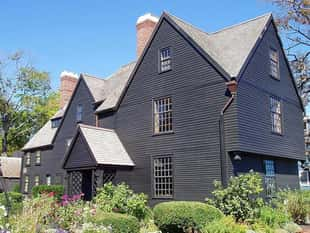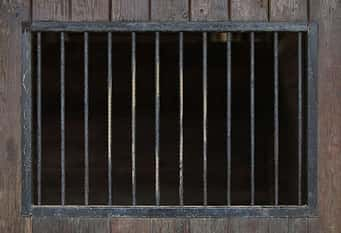Are you looking to move to Salem, Massachusetts? Perhaps you’re in search for a posh apartment building. If so, then we have got the perfect home for you: exposed brick walls, large glass windows, iron gates . . . within your apartment, and, naturally, a ghost or two.
If this sounds like your perfect home, then look no further than 50 St. Peter’s Street. It’s historic, it’s haunted and it just so happens to be the country’s first established penitentiary. You see, this now luxurious apartment building is none other than the Old Salem Jail, not to be confused with the Old Witch Gaol, which sits a few blocks away.
While now decked out with beautiful accents and an attached restaurant that draws in quite the crowd, the Old Salem Jail was once one of the most terrible places to end up for committing a crime. It served as the Boston Strangler’s “home” before his execution, and was also the site of more than a few well-organized inmate escapes.
Today, it’s hard to see the Old Salem Jail as anything but a beautifully restored historic building. But if you look closely enough, the tales of days gone by still peek through . . . And, if you believe the countless reports which have emerged since the property’s conversion to a residential building, the Old Salem Jail’s inmates have yet to leave.
Local Lore at the Jail and Howard Street Cemetery
It’s true that the Old Salem Jail was built in 1813, and that less than a single year later the Howard Street Cemetery was founded. What’s less clear is what came before the jail’s construction.
Tim Maguire, local historian and owner of Salem Night Tour, informed Sal Baltrusis (for his book, Ghosts of Salem) that back in the 17th century, the property was once the site for Giles Corey’s death during the Salem Witch Trials.
According to the history books, Giles Corey remained one of the few accused warlocks during the Witch Trials of 1692. A man in his 80s, Corey faced prosecution after rumors emerged that his spirit was wandering Salem Village and attacking young girls. Corey adamantly refuted these claims and denied that he had any involvement with witchcraft whatsoever. But rumors at this time were also synonymous with guilt, and Corey quickly found himself in a difficult position.
He could either plead guilty and a “fair” trial would ensue; or, he could maintain his innocence and proper punishment would be doled out. Corey did neither, refusing to speak the words that allow the trial to open.
Acting on the orders of Judge John Hathorne, the High Sheriff George Corwin, one of the most hated men of the era, dragged Corey to the then-empty land. All he had to do was say the words and the trial would take place. The words did not come, and so Corwin and the others laid Corey’s body out on the soil. They placed a wooden frame on his chest, and then began to layer stones on top of the wood, effectively crushing Giles Corey to death.
This method of torture went by the name of peine forte et dure, and, according to Tim Maguire, a “strangely large percentage of those buried in the Howard Street Cemetery had a similar fate to Giles Corey (who was crushed to death on the same land), in that they were crushed to death.”
Records show that this is not the case. Giles Corey was crushed on the same land of the Old Salem Jail, no doubt sparking some paranormal phenomena in itself, but Giles Corey remains the only person to ever be crushed to death or undergo such torture in the history of the Massachusetts Bay Colony.
What’s a haunted location without a few gruesome stories?
According to one particular gory tale, the Old Salem Jail was constructed with granite from nearby Rockport, Massachusetts. The granite was allegedly “salvaged” from St. Peter Street, and it’s widely believed by ghost tour companies that the slabs of granite used were once stained with the blood of the witch trial victims from 1692.
Do we believe this at Ghost City Tours? Not one bit, but it does make for an excellent tale to tell the little ones just before they head to bed at night.
In reality, the population of inmates had quickly outsized the old “old” jail during the early 1800s, leaving the City little choice but to build a new prison. In 1813, work on that new jail began.
Bryant F. Tolles, Jr., writes in Architecture in Salem that “John Page supplied the bricks, Joseph Newhall and Henry Williams furnished stone, David Robbins was the principal mason, and Joseph Edwards superintended construction.” (Nowhere is it mentioned that the stones were soaked with blood).
In the early days of the Federal-style jail, prisoners most commonly met their death by hanging. Most tally the hangings at an estimated 50 over the years--hangings, which allegedly took place in the prison’s dining area. (Because there is nothing like taking a meal as someone meets their maker at the same time)
But not all the hangings were done as punishment for a crime. On more than one occasion, inmates sought to take their own lives because of the terrible living conditions. In 1893, the Fitchburg Sentinel reported that one Charles Kenney of Lynn hanged himself in his prison cell. A prison guard found Kenney strung up by a towel, which he’d hooked to the wall and thrown his weight against.
For nearly 177 years, the Old Salem Jail (more formally known as the “Essex County Correctional Institute”) was a symbol of misery, despite a massive renovation and expansion in 1884/85. Architect Rufus Sargent (1812-1886) of Newburyport was chosen as Head Architect over other entrants in a design competition.
Sargent promptly set out to conform the Old Salem Jail to the new Victorian aesthetics, adding the infamous octagonal cupolas on the slate roof as well as a number of prison cells. But while Sargent managed to marry the Federal and Gothic styles, the interior of the prison still remained a cesspit.
In 1892, a little over a decade after the prison’s expansion, newspaper reports accounted for an “overflow of prisoners at the Salem jail.” The reason for the overcrowding? Apparently the county had recently passed an anti-alcohol law and the drunks were now all in prison. They worried that unless Essex County repealed the drunk law, they would be forced to built a new jail.
By the 1960s and 70s, the prison was still without modern indoor plumbing. Inmates were relegated to using five-gallon buckets as personal chamber pots. Once per week, they were given leave to use one of the two operating toilets in the whole property.
Inmates weren’t the only ones paying the price for a jail low on the state’s priority list. Correctional officers and security guards were forced to pay for their own badges and uniforms. One former corrections officer at the prison said that the jail “has a mystique all its own [...] We had to live the same way the inmates lived. The roaches crunched under our feet in the same way. We had to smell the same body odor and stink they did.”
In 1991, the time came to see the Salem Jail shut its doors. When the inmates were released to make the move to the new facility, they completely trashed the jail. Food was thrown; trash cans lit on fire; and the five-gallon urine buckets hurled at walls. According to the Salem Evening News, one “inmate wrote ‘we won’ in toothpaste [...] in the prisoner’s rectory.”
TVs were smashed, windows broken.
By the time that the riots quieted, the Old Salem Jail was a fractured shell of its former self.
For the next decade, the property sat vacant--a playground for vandals, teenage miscreants and squatters. When the City of Salem purchased the abandoned jail in 2001, it was for only one dollar. They desperately hoped that a developer would come along and reinvigorate life into the former jail.
But it was not until 2009 that the New Boston Ventures proposed historic luxury apartments for a whopping $10.7 million. On the first day on the market, 17 of the 22 apartments were swooped up for anywhere between $1,000-$2,700/month.
No one seemed to mind that they were now living in a place where riots happened regularly or that some of Boston’s most notorious criminals had been imprisoned there. For all sense and purpose, with the opening of the posh real estate, the jail’s dark and turbulent past was wiped away.
If only the spirits of the Old Salem Jail would allow the past to stay in the past.
Since the jail was abandoned in the early 1990s, sightings of ghosts have become quite regular happenings.
Those passing by the then-empty jail swore that they saw lights flickering inside, despite the fact that the prison was no longer hooked up to the electrical circuits. Eerie screams have been heard at all hours of the day, and for those who were brave enough to step within its abandoned walls often were witnesses to shadow people lurking in the halls.
But who are the ghosts of the Old Salem Jail? Is it Giles Corey, the accused warlock who was pressed to death? Or perhaps a number of the men who passed through the jail’s locked gates . . . some of whom never left?
Below are some of the infamous people who were imprisoned, visited or escaped from the Salem Jail.
In the 1960s, the Boston Strangler went by a variety of names: the Mad Strangler of Boston, the Phantom Strangler, the Green Man, among others. But perhaps one name he almost never went by was Albert DeSalvo, the man behind the thirteen murders.
Starting in June 1962, the Boston Strangler’s murder spree through Boston was both calculated and shocking. He had an allusive ability to coerce women into letting them into their apartments, in which he would strangle the women with, generally, her nylon stockings.
Of thirteen known murders, the nylon stocking method was successfully executed a total of eight times. The rest of the Strangler’s victims were stabbed to death.
Albert DeSalvo came into the picture when he allegedly entered a woman’s home posing as a detective in 1964. After assaulting her, he left and was later identified as the woman’s raper.
DeSalvo was immediately locked up in the Old Salem Jail (then the Essex County Correctional Institute). He confessed his identity as the notorious Boston Strangler to his fellow inmate, George Nassar, who then reported the admission to his attorney F. Lee Bailey.
DeSalvo was sentenced to life in prison in 1967, though he escaped from the Bridgewater State Hospital just a few months later. He was later caught, re-imprisoned and then found stabbed to death in the infirmary six years later.
Today, the Old Salem Jail’s most famous inmate is the Boston Strangler . . . but does he still haunt the jail? It’s possible that his spectral presence is the cause of many people feeling a threatening vibration in the air.
Over the years, there have been a number of inmate escapes from the Salem Jail. People have claimed to see full body apparitions sprinting across the front lawn as though desperate to finally make it out. In the dead of night when these ghosts are seen, the sound of chains rattling is never far behind.
In the Salem Jail’s history, there have been countless of well-planned prison breaks.
In 1891, the Boston Post announced yet another. Charles Duncan, “alias Charles Moore, alias Charles Mason, alias Charlson Willard” escaped on September 28, 1880, after assaulting and almost killing the prison guard, James Beaver. The attack left Beaver completely blind. Willard, not the brightest of criminals, was subsequently sentenced in another state, Maryland, on charges of forgery. Also for horse stealing, and yet also for holding a dangerous weapon. By the time he was reinstated in Salem Jail, Willard had been on the run for a decade and was 59 years old.
The Berkshire Eagle reported another break out in 1947. According to the report, “four desperate prisoners wielding guns seized and held control of the Essex County Jail for almost an hour early today and--after overpowering two guards--calmly changed into sport clothes, robbed the guards of $140 and fled in a stolen car.”
The escapees were later caught and sent back to jail.
And yet another prison break became notorious for its creativity, when a group of prisoners worked endlessly for months to dig a hole behind their wall. With ingenuity, they used toothpaste to glue the bricks back together and then concealed their escape plan with a poster. The prison guard never even realized that the inmates he was guarding were working tirelessly to garner a way out of the Salem Jail.
And if ghost sightings are anything to go by at this haunted location, the inmates are still trying to escape.
In one of the upstairs windows of the jail, it’s not uncommon to see a shadowy figure step close to the glass. Almost always, he is seen holding a candle as he roams from one room to another. But creepily enough, the floor that the spirit wanders no longer exists and is said to have collapsed years ago.
Who is this lonesome ghost still wandering the halls of the prison?
During the Civil War, confederate soldiers were allegedly imprisoned in the Old Salem Jail. More recently, there have been sightings of spirits wearing 19th century clothing at the old jail. Some believe these ghostly soldiers to be the source of the agonizing cries heard all throughout the night and some link these soldiers to the spirit with the candle.
If the gritty tales above didn’t pique your interest about the Old Salem Jail, knowing that Harry Houdini once staged one of his great prison escapes there in 1906 might do the trick.
Upon visiting Salem in April of that year, Houdini stripped naked and strapped on three pairs of handcuffs and two pairs of leg irons. He was put in the middle cell and, less than thirteen minutes later, had managed to escape his confines. He pulled his clothes back on, unlocked the rest of the cells, handcuffed himself to a prisoner and hightailed it to Front Street to show off to the City Marshal and the other dignitaries there.
Entertaining magic tricks aside, the Old Salem Jail’s history is an interesting one. From warlocks to Civil War soldiers, from Harry Houdini to the Boston Strangler, this jail has witnessed the lowest of the low and the highest of the high.
And, yet, nearly 200 years later, it still stands; a posh apartment complex with people vying for entry.
While you can’t visit the apartment building itself, be sure to stop at the A&B Restaurant downstairs which is open to the public. In case you’re wondering, the prison’s ghosts are said to haunt there too.
In death, there is no discrimination to haunting locales.

One of Salem's most famous haunted houses

Spend a night in Salem's most haunted hotel

One of Salem's most haunted places